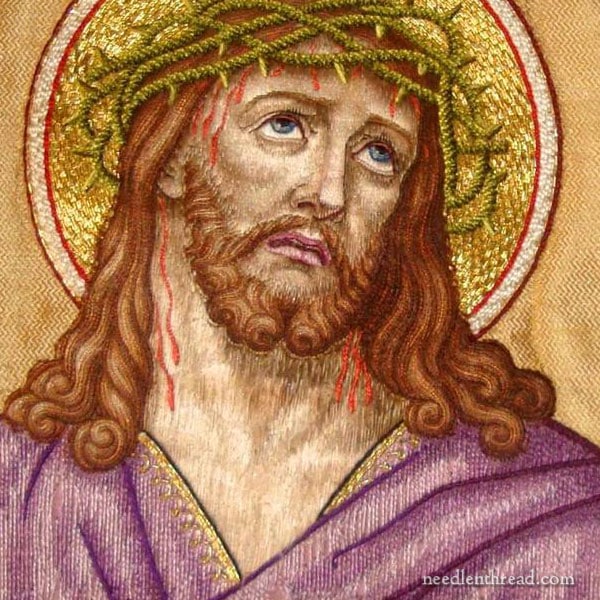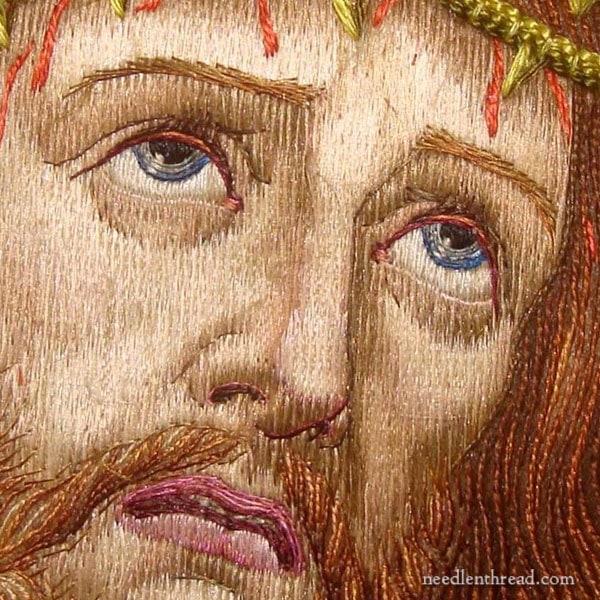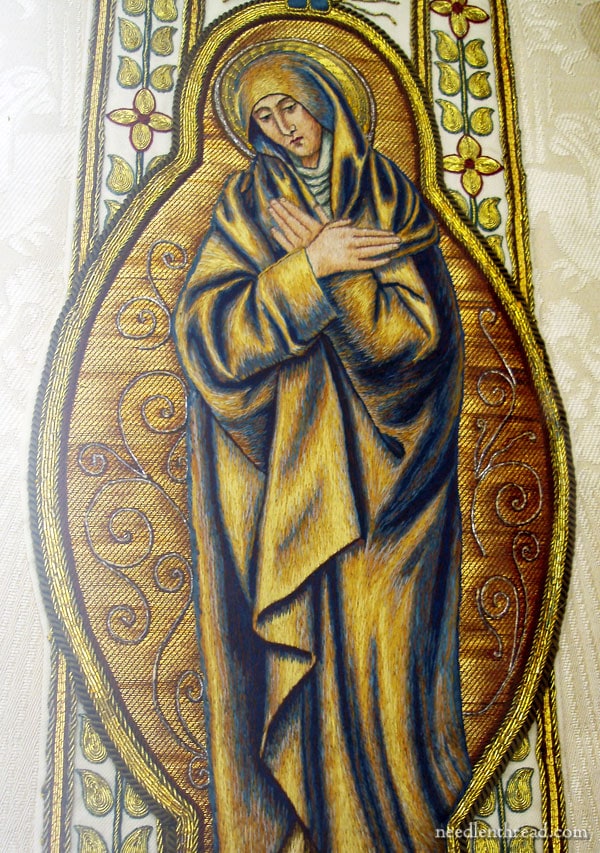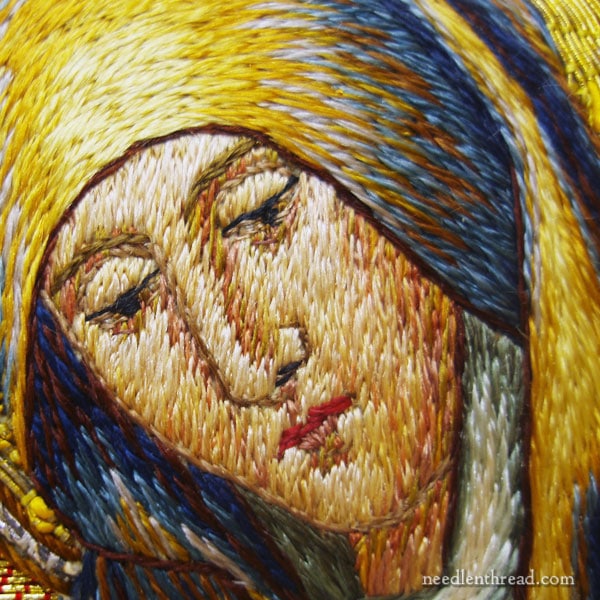Figures have played a dominant role in ecclesiastical embroidery since the Middle Ages.
During the era of Opus Anglicanum embroidery (1100’s through the end of the 1300’s), figures were the focal element of the style. The embroidering of saints and biblical figures to adorn vestments continued to develop after the Middle Ages. During the Renaissance, beautiful figure embroidery mixed with exquisite goldwork developed in Belgium, especially, and also in Spain, Italy, and other parts of Europe.
Into and through the 1700’s, floral elements became more common on vestments and vesture. And by the Industrial Revolution of the mid-1800’s, figures – while still figuring in ecclesiastical embroidery – began to deteriorate, in some regards, as far as quality is concerned. The fully embroidered figure began to recede from the more common ecclesiastical use, and figures that were a combination of paint and embroidery began to emerge, in keeping with the trends and desires for quicker turnout in textile-related production.
Still, figure embroidery even today is part of ecclesiastical embroidery.
Here are a few images of figure embroidery that are relevant for today. If you haven’t ever seen pieces like these up close, hopefully you’ll find them as fascinating as I do!

The figure above was the central medallion on the back of a vestment.
It depicts Christ as He suffered on Good Friday, in a pose referred to as the “Ecce Homo” – meaning “behold the man,” as drawn from John 19:5 of the Latin Vulgate. (Exivit ergo Jesus portans coronam spineam, et purpureum vestimentum. Et dicit eis : Ecce homo. This translates: “Jesus therefore came forth, bearing the crown of thorns and a purple garment. And he (Pilate) saith to them: Behold the Man.”)

The entire image of the face is only about 4″ – 4.5″ high from top of forehead to chin, so this isn’t a “large” piece.
When observed up close, the embroidery and the color choices may look odd or even a bit jarring. The lips, the eyelids – they look somewhat bizarre when you’re looking at them close up at this magnitude.
The key to viewing any ecclesiastical embroidery is that it is meant to be seen from a distance. Those details of color, stitch direction, and so forth that may look strange up close are what serve to make the features distinguished from a distance.
This piece is painted behind the embroidery, incidentally. It’s embroidered on silk, with silk, and the silk fabric is painted first. The lines of the embroidery are actually fairly sparse – just enough to give the impression of a fully embroidered figure.

This particular figure is the Virgin of Sorrows, and is found on a beautiful vestment in the museum at the Benedictine convent in Clyde, Missouri. This convent was known for its superior embroidery work from the 1800’s through the first half of the 1900’s.

Unlike the previous example of the Ecce Homo depicted above, this piece does not involve paint as an under layer in the design. On the contrary, it is solidly embroidered in silk, on silk.
The figure itself is probably not more than 12″ high. I don’t have an exact measurement, but it is not a large figure. The vestment it adorns features a lot of other figures, too – you can see photos of the whole vestment here.
What is particularly notable when you look at the close up image of the face is the blending of colors, textures, and stitch direction in such a way that, when you draw back and look at the full figure above, the shading is exquisite. What looks pretty flat in the close up looks much more dimensional when seen from a distance.
Ecclesiastical embroidery has been a favorite realm of exploration and study for me. It’s what got me into embroidery as an adult. Though I had toyed with stitching since I was a child, I never really saw embroidery as an art until studying art history in college and seeing some fantastic examples of ecclesiastical embroidery. It still fascinates me! Whenever I go anywhere, I look up churches and museums to see what they have to offer in the way of ecclesiastical needlework.
I hope that you enjoy seeing these photos today, if you hadn’t seen them before here on Needle ‘n Thread, and that they give you an appreciation for the skill and the development of figure embroidery in the later part of the 1800’s through the mid-1900’s.
A Little Break!
I’ll be taking a little break for about a week, to spend Easter with my family and then to tackle a couple projects on the technical side of things for Needle ‘n Thread. I’ll pop back in a week from today, when we will look at the outcome of an experiment in design transfer that I’ve been playing with – oh, it is messy! – and share with you some exciting news for the future of Needle ‘n Thread!
I hope you and yours have a Happy Easter, and I’ll see you next week!







Gorgeous! Thank you for sharing these on this Good Friday.
Enjoy your time off!
Have a very blessed Easter, Mary. All the best, Jeannette
Happy Easter, Mary – and a Big Thank You for all your dedication to spreading needlework throughout the world!
Angela from the Ore Mountains
Hi, Mary–any word about the state of historical vestments or other embroidery at Notre Dame?
Too soon to know?
Thanks!
I haven’t found any information on that yet, Lori, but I’ve been looking. It’s a rather specialized area, so I imagine that there won’t be much specific mention of the vestments, vesture, and the like in the news.
Deo Gratias for your gift of embroidery , love of Ecclesiastical embroidery, and teaching your love of embroidery to all of us. Easter Blessings!
Thank you for this and all the work you do to bring us all this information.
A very blessed and healthy Easter to you and your family Mary.
Have a blessed Easter
A Blessed Easter to you. This Ecclesiastical Figure Embroidery fascinates me. I always thought that the long and short split stitch all had to be the same length and direction, but looking at these close up pictures I can see this is not the case. Although most retain a general direction there seems to be smaller fill in stitches. Again, is gold material applique ever used in this type of work (i.e. like the gold roping in the crown of thorns – or is that a special gold stitch work that makes it look like real rope.) Such fascinating work!
Dear Mary
I hope you have a very special Blessed Easter with your family and I hope you have a good rest. Thanks for sharing with us these lovely vestments of Jesus Christ and for the history of them perfect for the time of year in celebration of Easter. I’m looking forward to hearing about the exciting news you have for us concerning Needle ‘n Thread. Enjoy your break.
Regards Anita Simmance
Thanks, Anita! It’s going great so far! Happy Easter to you and yours! 🙂
Dear Mary
Thanks for your reply yes I had a lovely Easter and spent time yesterday with my sister and Nieces and Great Nephew it was lovely. x
Regards Anita Simmance
G’day Mary,
Happy days to you and yours, keep safe and well.
Cheers, Kath.
Thanks, Kath! 🙂
Dear Mary, HE IS RISEN!
Have a wonderful Easter break! Thank you for all you do to bless us, teach us, and inspire us.
Blessings, Yr
🙂 Thanks!
Beautiful photos. I’ve never see this kind of thing up close. Amazing to see the stitching that looks like a painting from a distance.
Have a great Easter.
Thank you for this beautiful article. I feel privileged to be able to see this artwork right here on your website.
Hello. Can you tell me where I can obtain embroidery patterns for ecclesiastical figures (Icon of the Virgin and Child, and Jesus Christ)?
Thank you.